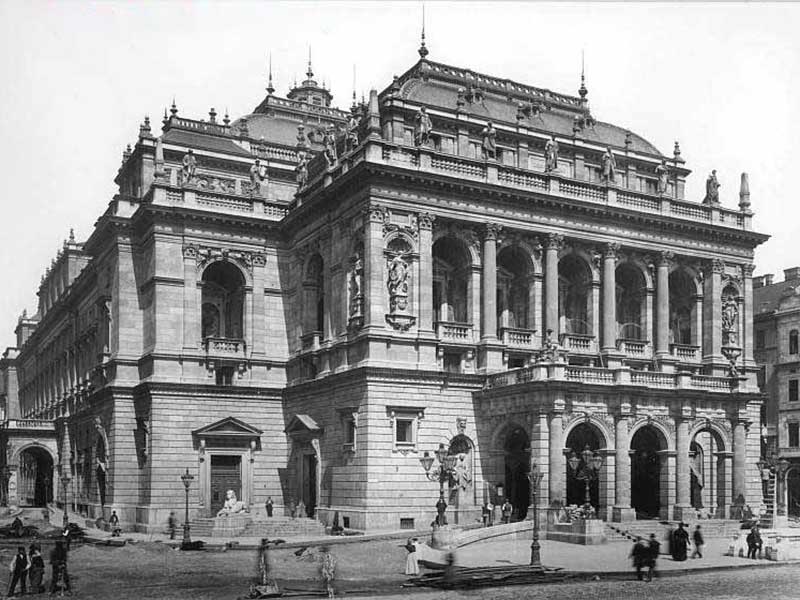The anniversary of Bartók’s 'Duke Bluebeard’s Castle', by Dr John Allison
posted on 27/05/20
Even without Covid-19 bringing down the shutters, Budapest’s Opera House on Andrássy út (Andrássy Ave) has been closed, and major restoration work is going on behind the theatre’s façade overlooking one the Hungarian capital’s most elegant avenues. But thinking of it in late May makes me long to return there as soon as possible – certainly no later than next May, and preferably for an anniversary performance of Béla Bartók’s only opera, Duke Bluebeard’s Castle. Few combinations of work and venue are more evocative of a great night in musical history, for Bluebeard was premiered there on 24th May 1918. Indeed, May 1918 was a remarkable month in Budapest’s musical life: just a fortnight before Bluebeard, Zoltán Kodály’s solo Cello Sonata, another singular masterpiece of Hungarian music, had its first performance.
Composed mostly in 1911, Duke Bluebeard’s Castle had to wait seven years for its premiere, seven years in which everything changed for – and around – those involved in its creation. Most ominously, there was the disaster of World War I, which had indeed been ignited in a province of the Austro-Hungarian Empire, but other certainties had come to an end in November 1916 with death of Franz Joseph I after a 68-year rule over his domains. The dual monarchy, which briefly passed to his nephew Karl, would itself last only until November 1918, and with dismemberment of Hungary just around the corner at the Treaty of Trianon, an atmosphere of unease and weariness hung heavily over the still-elegant streets of the empire’s second capital.
To have been there would have been to witness the birth of a fresh and new musical style distinct from anything else, though of course one connected to changing artistic currents elsewhere in central Europe. Wagner and Richard Strauss were early influences on Béla Bartók’s style – the first Budapest performance of Also sprach Zarathustra in 1902 had galvanised the young composer, as can be heard in his symphonic poem Kossuth of 1903 – but his immersion in Magyar and Romanian folk music was to change all that. Though Bartók initially struggled to find an audience for his music, things improved with the successful 1917 premiere at the Budapest Opera House of The Wooden Prince, which itself paved the way there for Duke Bluebeard’s Castle the following year. In keeping with the Expressionist tone of the times – and Béla Balázs’s Bluebeard libretto is very much an Expressionist tragedy, dealing allegorically with the inexpressible privacy of our innermost selves – the opera is startling in its originality, at once thoroughly Hungarian and utterly modern. This premiere changed the musical landscape within an hour: the duration of this most compact of great operas.
As midwife to the opera, the great and fascinating figure of Count Miklós Banffy would have been much in evidence. Showing rare artistic talent for an Intendant, he had designed the sets himself, and indeed it was his belief in Bartók that had enabled both Bluebeard and Wooden Prince to reach – despite considerable opposition – the stage. A Hungarian-Transylvanian nobleman, Banffy had had responsibility for arranging the last Habsburg coronation in Budapest and in the early 1920s would go on to serve briefly as Hungary’s Minister for Foreign Affairs. But his most lasting legacy is the 1,500-page Transylvanian Trilogy, surely the finest literary exploration of the decline of the Austro-Hungarian Empire, and equally powerful for its journey through haunting human dramas and luminous landscapes.
Just as the light and hope of those blazing organ chords at Bluebeard’s famous Fifth Door quickly give way to gloom, so the premiere’s success felt short-lived. Admiral Horthy’s soon to be installed right-wing regime made further performances impossible for 20 years. In common with that other ‘marriage’ opera, Fidelio, this one had no real operatic offspring, and was to remain – like its male protagonist – isolated.
Dr John Allison
MRT lecturer
View tours led by Dr John Allison
